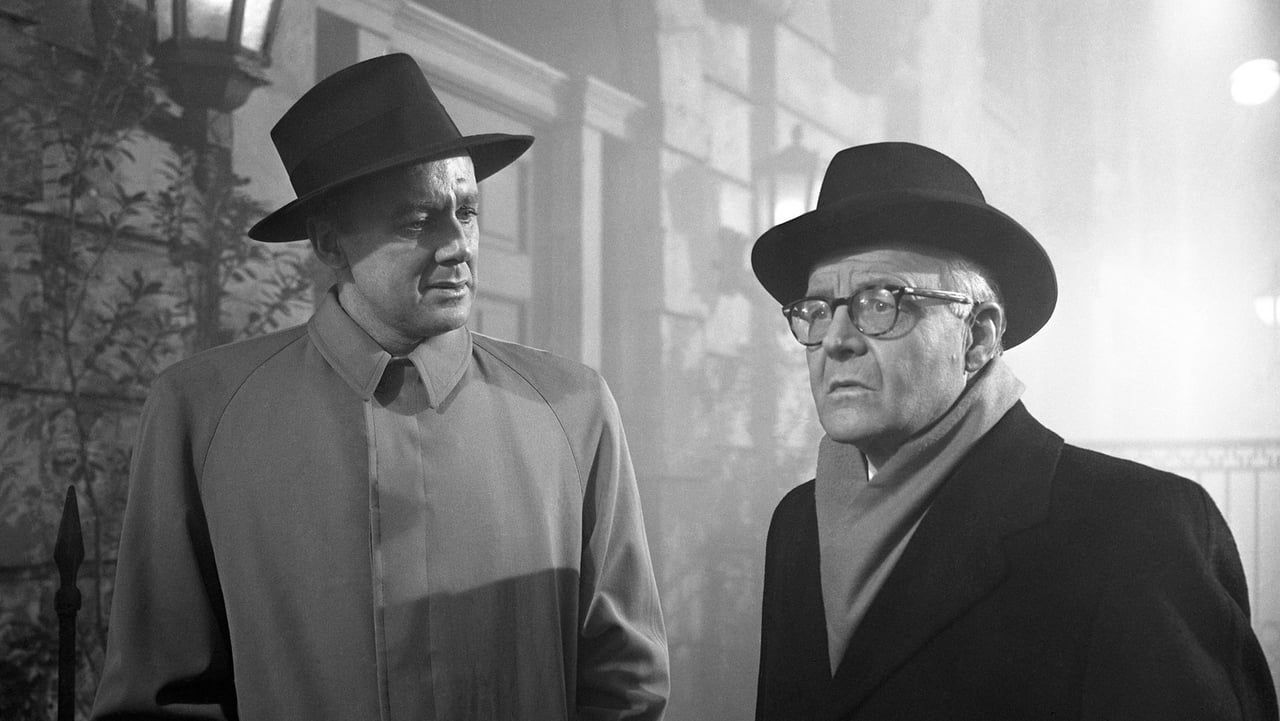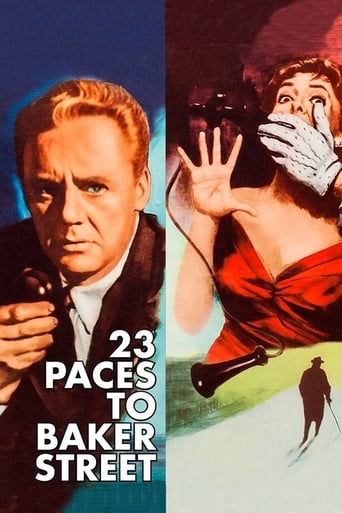

Although a definite Hollywood production with a couple of American leads, 23 PACES TO BAKER STREET is a London-set adventure actually filmed in our capital. It was shot by the reliable Henry Hathaway, whose lengthy career is studded with exciting adventures, war films, and dramas with a sheen of quality to them. This one is no exception.As the viewer watches the story unfold, quite slowly at first, it becomes quickly apparent that this film was heavily inspired by REAR WINDOW. The structure and narrative is almost identical, with Jimmy Stewart's invalidity replaced by Van Johnson's blindness. The plot seems a little insignificant at first, but there are some strong set-pieces to keep it moving along, particularly the delightfully funny scene in which Cecil Parker's put-upon manservant tails a lead.The stakes are raised in the second half of the film with certain sequences right out of Hitchcock, who is of course a big inspiration for Hathaway. The fog-enshrouded London scenes look great and fine performances are elicited from bit players including Liam Redmond (whose friendly role hearkens back to FOREIGN CORRESPONDENT) and Patricia Laffan as a femme fatale. Van Johnson was never a top tier lead but he's fine here and convincing as the blind man and Vera Miles is equally good as the Grace Kelly stand-in. The last part of the film is as suspenseful and exciting as you could hope for.
... View MoreThis is a very good mystery film shot in colour in the mid-fifties in London by Henry Hathaway. There are lots of spectacular shots of the River Thames in the sunset and at night. It is fascinating to see the river as it was then, when so many more smokestacks were standing and none of today's developments had taken place other than the 1953 construction of the Royal Festival Hall. The river was still being used a great deal, but the streets of London are very bare of traffic, and there are still bombed-out buildings standing, in one of which there is a harrowing scene where the star, Van Johnson, nearly falls several storeys into the street from the top floor because the entire front of the building has been missing since the War and, ten years later, the house has still not been demolished. Bomb sites in London were still common sights right the way through the 1960s. In this film, Van Johnson plays a successful American playwright living beside the Thames in London who within recent years has lost his sight. He had been engaged to his former secretary, played by Vera Miles, but upon going blind he had called off the engagement because he decided he had become an object of pity, and a drag upon her. As the action of this film begins, Miles has just travelled from America to try to resurrect her relationship with him, but he keeps rejecting her out of pride and not wishing to become dependent. Johnson has a butler, chauffeur and valet, played by Cecil Parker, who looks after him. Johnson clearly has plenty of money and lives in a very spacious and well-furnished flat. Johnson is learning how to get about with his walking stick and has mastered the journey from his flat to a pub across the street called The Eagle, where the barmaid is played with whimsical cockney charm by the elderly Estelle Winwood. I knew Estelle very well when I was young (when she was, I believe, in her 80s) and she was far from being a cockney! As a genteel person by origin, how she must have enjoyed this, because she had a tremendous spirit of fun and, for someone so thin who looked like a handful of sticks thrown together, remarkable energy! In this film she wears a substantial wig, as her own hair was very thin. We only see Estelle far away from the camera. Henry Hathaway was not a closeup man. I cannot recall a single closeup of any actor in this entire film. Very bad directors sometimes make films in a series of long shots. Hathaway does not do that, because he is far too experienced, and he likes two-shots and mid-shots. We thus do not feel in the film that everything is happening at the wrong end of a telescope. But somehow we never get to see a face up close. This stands out today, in an era of twitching eyebrows and swivelling eyeballs, where the closeup is king. Vera Miles has very little acting to do, as she is merely a cipher in the script. It is her duty to 'stand by her man' despite all the discouragements he can throw at her. Somehow we know that true love will triumph, but I am not permitted to say whether it does or not. The story is a very good one. Sitting one night alone in the Eagle, with his back to the glass panel of the Ladies Bar, against which we can see two silhouettes of heads chatting with each other, Johnson's super-acute hearing picks up an alarming conversation. A dastardly crime of kidnapping a child is being plotted by a Mr. Evans and a woman who appears to be a nanny. Johnson, being blind, cannot see the pair when they leave, but notes that the woman is wearing the expensive perfume 'Plaisir d'Amour', which hardly seems appropriate for a mere nanny. Johnson becomes determined to prevent the crime, the date of which, July 10, he had overheard. He summons the police but they say there is not enough to go on, and will not investigate. Johnson determines to investigate on his own, with the aid of his valet and Vera Miles, who has clearly turned up again at just the right time to make herself useful. The story of how they accomplish the seemingly impossible task of tracking down the criminals is truly impressive, and the film is very engrossing. But there are still many more hurdles ahead of them, and they themselves are now in danger. The motif of the lone blind man being stalked by an assailant whom he cannot see, but from whom he protects himself by turning out all the lights so that they are both left in darkness, is played to the hilt. The film is based on a novel by the British writer Philip MacDonald (1901-1980), which perhaps explains its plot richness. MacDonald is perhaps best known as the screenwriter for Hitchcock's REBECCA (1940), and he wrote many mystery film stories and scripts. The screenplay for this one was written by Nigel Balchin (1908-1970), who also wrote many well-known films and stories for films. Henry Hathaway (1898-1985) was a famous director of 67 films, including the well-known NIAGARA (1953) with Marilyn Monroe and TRUE GRIT (1969) with John Wayne. One of his most fascinating thrillers was THE HOUSE ON 92ND STREET (1945, see my review).
... View MoreAs the embittered, but successful playwright, Van Johnson gives a wonderful performance. He is followed to England by his ex-secretary, the woman he was supposed to marry, played well by Vera Miles.As is the case with so many films of this genre, Johnson, while in a pub, overhears some sort of plot and the film then becomes devoted to him trying to sort out the information and prevent whatever is going to happen from occurring.His faithful man servant is there with him all the way; of course, there are problems as the London police are quite skeptical of Johnson's plot.How he is able to sort this out is quite interesting. There are plot twists as we eventually find out that a kidnapping was on the way. You can't believe who is involved in this sinister plot.
... View MoreOkay, so in story 23 Paces to Baker Street mayn't be the most original on the block, but it doesn't necessarily need to be to be entertaining. There may be the odd cliché about, however there is much to enjoy namely the suspenseful and Hitchcockian-like story and the telling and suspense of it is very taut too. The film is very well made, with stylish photography and striking production values while I enjoyed the traditional fog used. Henry Hathaway's direction is excellent too, the screenplay is cracking, Van Johnson is very good in an ideal role, Vera Miles is suitably sympathetic and the support cast are faultless. Overall, very entertaining, well made and suspenseful film and worth repeat viewings. 9/10 Bethany Cox
... View More